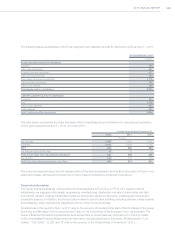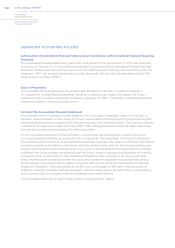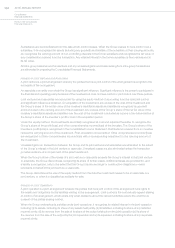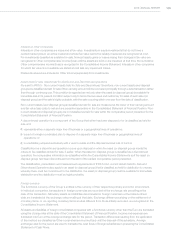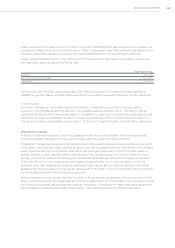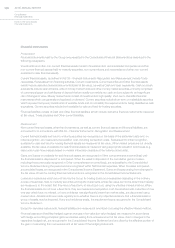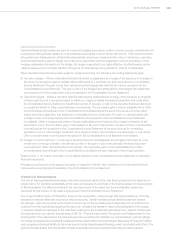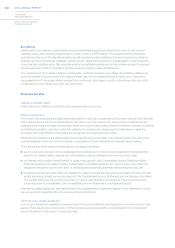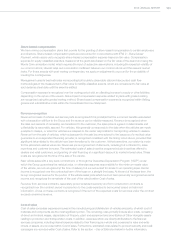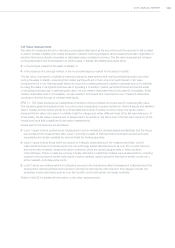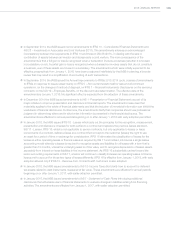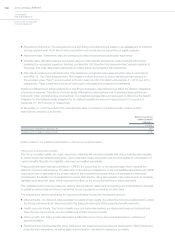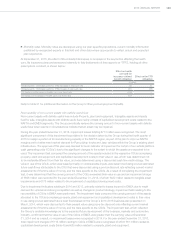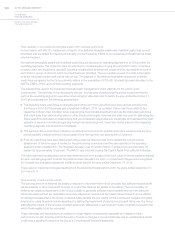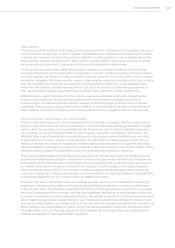Chrysler 2015 Annual Report Download - page 151
Download and view the complete annual report
Please find page 151 of the 2015 Chrysler annual report below. You can navigate through the pages in the report by either clicking on the pages listed below, or by using the keyword search tool below to find specific information within the annual report.
2015 | ANNUAL REPORT 151
Share-based compensation
We have various compensation plans that provide for the granting of share-based compensation to certain employees
and directors. Share-based compensation plans are accounted for in accordance with IFRS 2 - Share-based
Payment, which require us to recognize share-based compensation expense based on fair value. Compensation
expense for equity-classified awards is measured at the grant date based on the fair value of the award and using the
Monte Carlo simulation model, which requires the input of subjective assumptions, including the expected volatility of
our common stock, interest rates and a correlation coefficient between our common stock and the relevant market
index. For those awards with post-vesting contingencies, we apply an adjustment to account for the probability of
meeting the contingencies.
Management uses its best estimates incorporating both publicly observable data and discounted cash flow
methodologies in the measurement of fair value for liability-classified awards, which are remeasured to fair value at
each balance sheet date until the award is settled.
Compensation expense is recognized over the vesting period with an offsetting increase to equity or other liabilities
depending on the nature of the award. Share-based compensation expense related to plans with graded vesting
are recognized using the graded vesting method. Share-based compensation expense is recognized within Selling,
general and administrative costs within the Consolidated Income Statement.
Revenue recognition
Revenue from sale of vehicles and service parts is recognized if it is probable that the economic benefits associated
with a transaction will flow to the Group and the revenue can be reliably measured. Revenue is recognized when
the risks and rewards of ownership are transferred to the customer, the sales price is agreed or determinable and
collectability is reasonably assured. For vehicles, this generally corresponds to the date when the vehicles are made
available to dealers, or when the vehicles are released to the carrier responsible for transporting vehicles to dealers.
Revenue from the sale of vehicles, which subsequent to the sale become subject to the issuance of a residual value
guarantee to an independent financing provider, is recognized consistent with the timing noted above, provided that
significant risks related to the vehicle have been transferred to the customer. At that same time, a provision is made
for the estimated residual value risk. Revenues are recognized net of discounts, including but not limited to, sales
incentives and customer bonuses. The estimated costs of sales incentive programs include incentives offered to
dealers and retail customers, and granting of retail financing at a significant discount to market interest rates. These
costs are recognized at the time of the sale of the vehicle.
New vehicle sales with a buy-back commitment, or through the Guarantee Depreciation Program (“GDP”) under
which the Group guarantees the residual value, or otherwise assumes responsibility for the minimum resale value
of the vehicle, are not recognized at the time of delivery but are accounted for similar to an operating lease. Rental
income is recognized over the contractual term of the lease on a straight-line basis. At the end of the lease term, the
Group recognizes revenue for the portion of the vehicle sales price which had not been previously recognized as rental
income and recognizes the remainder of the cost of the vehicle within Cost of sales.
Revenue from services contracts, separately-priced extended warranty and from construction contracts is
recognized over the contract period in proportion to the costs expected to be incurred based on historical
information. A loss on these contracts is recognized if the sum of the expected costs for services under the contract
exceeds unearned revenue.
Cost of sales
Cost of sales comprises expenses incurred in the manufacturing and distribution of vehicles and parts, of which cost of
materials and components are the most significant portion. The remaining costs primarily include labor costs, consisting
of direct and indirect wages, depreciation of Property, plant and equipment and amortization of Other intangible assets
relating to production and transportation costs. In addition, expenses which are directly attributable to the financial
services companies, including interest expense related to their financing as a whole and provisions for risks and write-
downs of assets, are recorded within Cost of sales. Furthermore, estimated costs related to product warranty and recall
campaigns are recorded within Cost of sales. Refer to the section —Use of Estimates below for further information.


